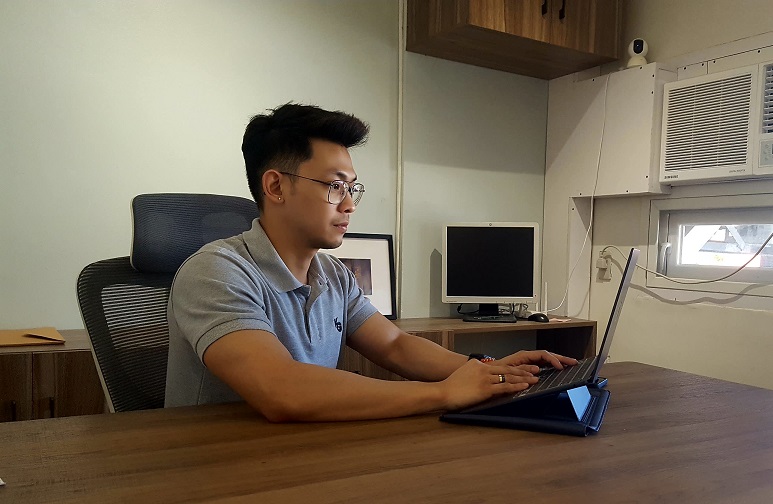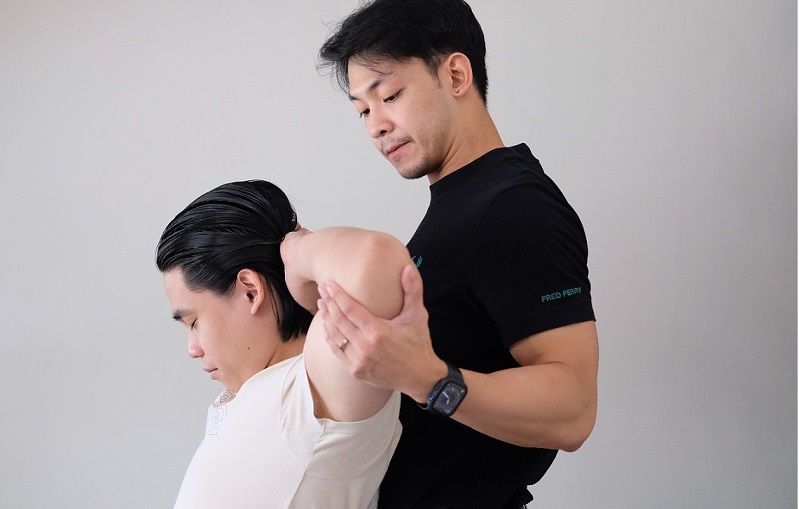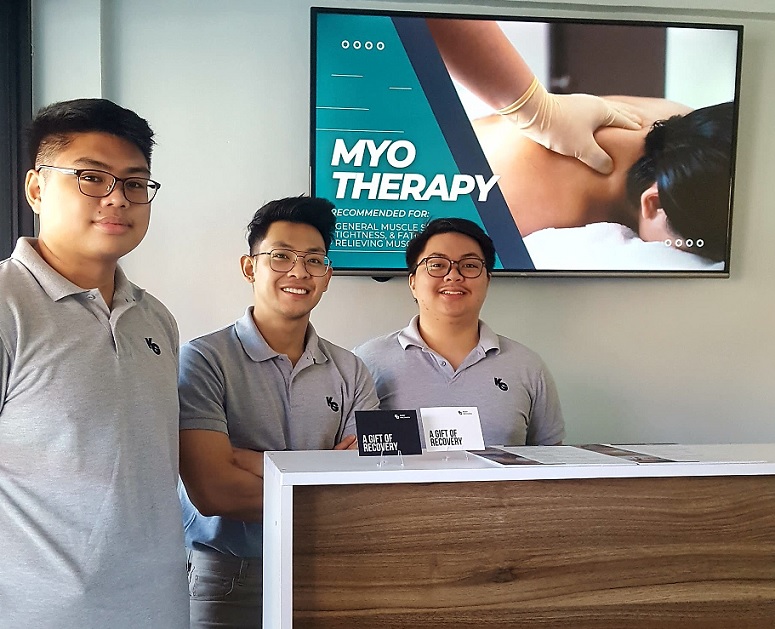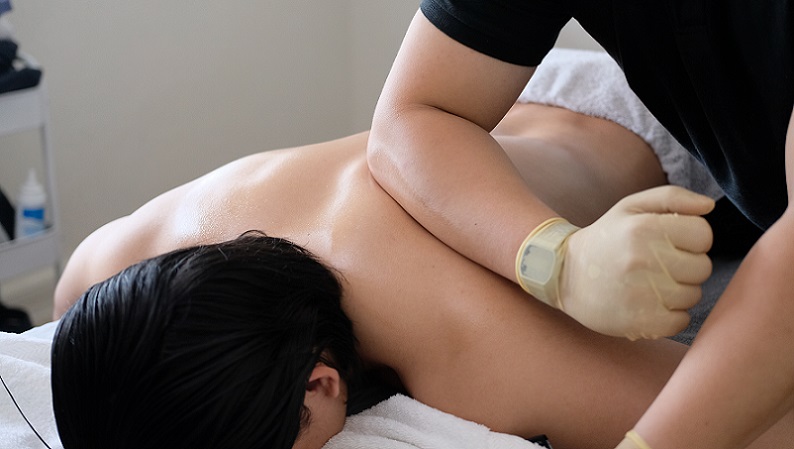Kenneth Giron chafed at being called masahista (Filipino for masseuse or masseur) when he was still a student at the University of Santo Tomas (UST). People then didn’t really make a distinction between a masahista and a physical therapist.
Giron, now a licensed physiotherapist, recalled being riled to the point that he found the term offensive. It undermined his future profession and his sacrifices in studying physical therapy. But he didn’t escape his friends poking fun at him either; ironically, they ran to him when they felt achey. Ignoring their ribbing, he made them into his practice dummies so he could sharpen his manual techniques. The tomfoolery stopped altogether when his magic fingers made their aches and pains go away.


He was able to let the masahista label slide off his back only after he graduated and started working.
“Technically, I am a massage therapist because I know about muscles, [except now] they’re paying my professional fee,” Giron says during our tête-à-téte at KG Body Recovery, his two-story clinic on West Avenue, Quezon City.
He opened KG Body Recovery in July 2023 with a laser focus on helping people be free of bodily pain. While most of his co-physiotherapists aimed to work overseas, he wanted to own a clinic, following in the footsteps of his hospital supervisors who started their own practice.
“There’s a general lack of awareness among people that physical therapy can be preventive therapy,” he explains. “They think it’s only meant for post-surgery or stroke patients, and thus, they prefer to see masseurs/masseuses first then go to physiotherapists when they’re in pain.”


Ear to the ground
Giron, 30, isn’t begrudging others of choosing to leave for greener pastures abroad, but neither is he brandishing privilege. He’s got his ear to the ground: Physical therapy training in the country serves as a stepping stone for working overseas because of the higher remuneration and opportunities.
His view is strengthened by Michael Gabilo, president of the Philippine Physical Therapy Association, in bohol.news, who expressed hope that House Bill (HB) No. 8452, or the proposed Philippine Physical Therapy Law, “[will] encourage more physical therapists to stay and serve in the country.” HB 8452, which was approved on final reading by the House of Representatives in August 2023, aims to address issues and challenges experienced by physiotherapists in relation to education, training, employment, and migration. It sets the scope and limitations of practice, code of ethics, Continuing Professional Development (CPD), and disciplinary action for violators.
Giron’s best friend went overseas and, despite being financially set and a permanent resident in Canada, she admitted to him that something was still lacking. Working abroad has definitely crossed Giron’s mind, but, as he puts it, the Philippines is home. If he travels overseas, it’s to “destress and clear [my] mind.”
Assessing the situation, he believes that it boils down to the physiotherapists’ decision: Some go overseas, some practice in the provinces, and others take advanced studies.
“A physiotherapist should aim for what fulfills him/her,” he says.
Giron’s choice: operating KG Body Recovery ((IG page @kgrecovery.ph. Contact numbers +63 908 102 3846 | 8645 0335)despite having to grapple with the business aspect of running a clinic, for which he had no training. It’s solely his own project, from securing the requisite business permits — the most challenging to do, he quips — down to supervising construction, designing the interiors, planning the services menu, and training the staff. He received moral support from his two older siblings, preferring to do everything himself.
“The clinic is nothing if it’s only for money, I want it to be a fulfilling [venue] so the physiotherapists I hire would [also] find it fulfilling to work here,” says the sports enthusiast who envisions satellite branches in the provinces in the future.
He adds: “I hope I can provide physical therapy services in the less fortunate areas, [to those] who can’t afford or lack the knowledge.”
Comparatively, the clinic is a bigger undertaking from his freelancing days of rehabilitation home service and using his condominium to accommodate those needing space for therapy work.
On the job
With his hands-on approach, Giron spent a month training newly hired staff, who, he says, were quick studies. They had the know-how down pat, but lacked the practical experience, having only done online training during the pandemic. However, it was vital for him to establish from the outset that they must share his vision of “working to be able to help people.”
With clients, Giron guards against giving the impression that what his clinic does is the norm; it’s not. Physiotherapists may have the same knowledge, but they have their own techniques. He does follow general protocols of, for example, asking for the clients’ specific concerns and providing a detailed explanation and assessment so they can have a better understanding of the treatments. There’s also a follow-up text to see how they’re feeling two days after the session.
Becoming a physiotherapist isn’t a cakewalk. If truth be told, Giron found the first four years difficult, sacrificing his time with family and friends for his studies. It was only in his fifth and final year — when he went on his yearlong internship in nine hospitals around Manila — that he had an epiphany of how satisfying being a physiotherapist can be. And it was a job at a sports rehab clinic working with mostly stroke patients and those with lower back problems that led him to his area of focus: musculoskeletal health.
“A lot of people don’t know that muscle pain can be treated,” Giron points out. “[Physical therapy] isn’t just for athletes: [it’s] for people with sedentary lifestyles, too. I helped them and found it fulfilling. I also learned techniques that I didn’t learn in college. Generally, people experience muscle pain [which is] a broader area where I’m able to help.”
His new knowledge led him to develop KG Body Recovery’s trademark treatment –the myofascial release therapy (MFR), which enhances the body’s natural mobility, releases tightness, and eases pain through application of gentle hand pressure and stretches.


Tellingly, Filipino physiotherapists are more prone to pain and fatigue because they literally lift patients by themselves, unlike their counterparts abroad who are assisted by machines.
“Everything is done manually in the Philippines, i.e., carrying a stroke patient,” Giron says. “They become tired, and thus, don’t offer proper care. Most private hospitals would rather spend the money on labor than on expensive machines.”
Professional practitioners
Per the June 2023 Country and Profession Profile by World Physiotherapy, a global body for 128 physiotherapist member-organizations, there are 16, 605 practicing Filipino physiotherapists in the country, 64 percent of them female.
The number has gone up with the addition of new professionals in the field. According to rappler.com, 1,288 out of 1,884 examinees passed the licensure tests administered by the Board of Physical and Occupational Therapy in December 2023. The Pamantasan ng Lungsod ng Maynila was the top performing school with a passing rate of 98.23 percent, followed by UST with 97.44 percent, and Silliman University with 92.19 percent.
Giron thinks physiotherapists should be licensed to practice their profession for three years after which they have to renew their license. The easy part of license renewal is attending seminars to earn the needed credits and units for CPD. However, a major stumbling block to acquiring the CPD credits is the exorbitant seminar fee that runs into thousands of pesos.
It’s one of the issues Giron hopes will be resolved with HB 8452, asserting that having the seminars free of charge can greatly help physiotherapists who only earn minimum wage. Workers’ compensation and the budget for healthcare are the other issues that should be looked into, he adds.
Rising market
The view that physical therapy is meant for those recovering from a medical condition or procedure still holds, but the overall picture has expanded. It is now seen as a viable alternative to medication and surgery, and a way to help senior citizens who require therapeutic exercise.
A report by www.insights10.com, “Philippines physiotherapy market analysis,” states that physiotherapy-based rehabilitative care has become increasingly relevant in the country because of the greater access to cutting-edge medical, emergency, and trauma treatment. It’s become a common part of the healthcare process at many facilities, bolstering, in turn, a demand for physiotherapy and rehab equipment.
Significantly, the physiotherapy market size of the Philippines in 2022 was valued at AUS$34 million. It’s predicted to expand at a compound annual growth of 16.30 percent from 2022 to 2030, reaching $133 million in 2030, according to the same report.
Part of the growth drivers of the market are the expanding senior population and the growing number of professional physiotherapists. Conversely, its pull factors are the healthcare insurance plans’ coverage and pricing, expensive physiotherapy treatments, and the patients’ ability to pay out of pocket.
Pain relievers
The immediate endgame at KG Body Recovery is not relaxation but pain alleviation that entails riding the wave of the pain until it’s released from the body through, for example, MFR or dry needling — the clinic’s key and effective treatments for muscle pain relief. The relaxation comes days later when one is moving without pain.


For the uninitiated, dry needling isn’t acupuncture. Per www.turningpointphysio.ca, dry needling uses thicker needles and targets trigger points within the muscles to relieve tension and decrease pain. Acupuncture, on the other hand, uses very thin needles and stimulates energy flow within the body.
MFR and dry needling can be combined with another therapy, cupping. The clinic’s handout says that with the use of special plastic cups, the muscle tissue and fascia are “lifted” to increase the blood flow to the sore areas of the muscles, thus reducing pain and decreasing soreness.
Cupping was my introductory therapy at the clinic before I had dry needling in the next session. A few sessions later, I combined the two.




Clarifies Giron: “[As] a physiotherapy clinic, I only offer services that are in line with physical therapy or what we do as physiotherapists. I don’t want to use any other treatment that’s not effective.
Giron and his team — Emmanuel Luis Manila, Arvydaz Esquig, and Kate Monique Conde — commonly treat the back and shoulder problems of their predominantly male clients although they also handle sports-related injuries, muscle and joint pain, frozen shoulder, etc. Giron surmises that the clinic’s demographic trend towards males — 60 to 70 percent attendance rate — is linked to the widespread idea of women having a higher tolerance for pain than men.
So who do they turn to when they themselves are in need of care? Giron usually did self care and turned to his former supervisor for his back problems before opening his clinic. After he got his clinic up and running, he’d ask one of his physiotherapists for help and vice versa.
Greater longevity
Shedding its bad connotation, the word “therapy” has become synonymous to “self care” — minus the implied narcissism — and an essential step in a fitness regimen. Giron notes that the pandemic brought about this sea change in the view, which made the current generation more health-conscious and, thus, inclined to prioritize self care.
Similarly, the outlook on physical therapy has changed although its link to continued wellness has yet to gain a firmer hold in the people’s minds. Giron declares it’s crucial for greater longevity when asked on its importance in life. It’s the treatment that helps people who don’t listen to their bodies clamoring for rest and those encumbered by pain while shaking off their sedentariness or going about their daily routine.
The physiotherapist provides that connection between rest and recovery, he stresses.
Musculoskeletal health has long been put on the back burner when it shouldn’t have, being an integral part of healthy living. See it this way: If an apple a day keeps the doctor away, a physiotherapist will get you quickly on your feet and keep the ache at bay.


